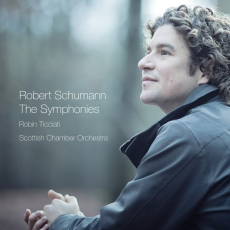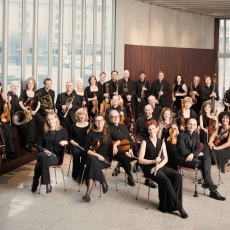Robin Ticciati & SCO - Schumann: The Symphonies - Classical Source
Recently there have been several recorded sets of Robert Schumann's Symphonies for which the commentaries in the accompanying booklets have in different ways suggested that despite the popular misconception that the composer's orchestrations are questionable that it is not at all problematic when performed correctly. Even the composer's sometimes-criticised revision and re-orchestration of No.4 is now thought to be admirable. Two sets - one from Yannick Nézet-Séguin and this conducted by Robin Ticciati - employ chamber orchestras, but it must not be assumed that this nomenclature represents a reduction in size merely to clarify the scoring - and certainly ‘reduction' does not apply because the Scottish Chamber Orchestra used 32 strings and Schumann's orchestra in Leipzig used 31. .
It is interesting to compare Ticciati with Nézet-Séguin because, despite the latter consistently taking faster speeds, both conductors choose to shape the melodies with a subtle rubato without impeding the forward progress of the music. Generally Ticciati is a little freer with his phrasing and from the outset of No.1 the approach, and for that matter the acoustic, is more spacious. Firm, confident playing from the outset enhances this strong interpretation; a forward-moving slow movement precedes a powerful scherzo but arriving at the finale the more personal approach of Ticciati becomes evident. Usually the opening fanfare is followed by the cheerful main theme being launched at a speed which recognises the Allegro animato marking but Ticciati eases graciously into the melody, awakening at the first tutti (but not too suddenly). I particularly appreciate the phrasing not being identical on the repeat of the exposition. A subtle leaning on the upbeat to the main tune is rather charming and although done frequently it does not seem eccentric.
Big and bold is the approach to Symphony No.2 and the dramatic link from the long slow introduction to the Allegro non troppo typifies the conductor's understanding of Schumann's construction. It is worth recalling Nézet-Séguin's method because it shows how different interpretative views can be equally effective: a slower but equally unaffected approach to the scherzo is given by Ticciati, and similar sensitivity despite differing tempos informs both performances of the Adagio espressivo; and it is interesting that two differing renderings give a similar impression of the eager nature of Schumann's finale. Seguin drives with a hint of fierceness while Ticciati leavens his drive with touches of grandeur. Both are convincing.
The ‘Rhenish' opens majestically and, throughout, the clarity of the recording is impressive. I like the weightiness of the unhurried intermezzo-like Scherzo and there is great depth of feeling in the slow movement. The solemn use of brass in the ‘Cologne cathedral' movement is displayed realistically and the firm pizzicato accompaniment at the start gives a sense of stability. Typically, Ticciati eases gently into the finale - I am not sure that he conceals the slightly fragmentary nature of the music but the optimistic nature of Schumann's muse is well demonstrated and the coda is very exciting - superb horns here.
Power is provided in the Fourth Symphony and Schumann's oft-used marking, Lebhaft(lively) is obeyed for the fast part of the opening movement without any risk of hurry and the increase of speed at the close is taken with discretion making the lead into the calmness of the succeeding ‘Romanza' seem all the more natural, but as for the scherzo - oh dear! Lebhaft is the simple, and only, indication of how it should be played but suddenly this is forgotten when the trio is reached and here the tempo completely collapses. ‘Somnolent' would be my description, because this section - a peasant dance by nature - here trundles gloomily and hesitantly along with virtually no rhythmic pulse. This outworn tradition of playing this section in a soggy fashion has spoilt many reading. Trawling through alternative versions to hand, only Klemperer avoids such a breakdown and even he is a trace under basic speed. The finale is crisp and clear with an interesting understatement of the three grand chords with which it opens. There is an electrifying coda which pays due respect to Schumann's use of timpani.
Robin Ticciati joins the distinguished list of today's conductors treating Schumann's Symphonies with the respect they deserve. At times he includes a few personal notions but each of them throws light on the passage in question.


